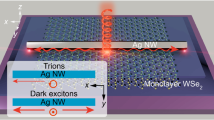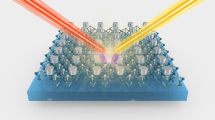Abstract
Two-dimensional (2D) materials with exotic photophysical effects and prominent optical performance are considered suitable nanobuilding blocks for optoelectronic device applications. Among these materials, indium selenide (InSe) has attracted enormous research attention owing to its unique structure, high layer-tunable optical response in the visible to near-infrared regions, and substantial second-order nonlinear optical properties. However, InSe features an extremely weak response to normal incident light (in-plane polarization) because its band-edge excitons are oriented out-of-plane, which considerably limits its practical applications. Herein, by integrating few-layer InSe with an Ag nanoprism array, we substantially improved the optical response of InSe in linear and nonlinear regimes. The enhanced response is attributable to the synergy between two mechanisms. First, the resonant excitation of the local surface plasma enhances the coupling efficiency of InSe with the incident light; second, the unique bending structure increases the out-of-plane polarization component of the incident light, resulting in enhanced light absorption and scattering by the out-of-plane excitons at the InSe band edge. We further achieved a two-order magnitude enhancement in the photoluminescence and second-harmonic generation intensities by tuning the InSe thickness. This paper proposes an effective approach for improving the optical properties of InSe, contributing to its practical applications in optoelectronic devices.

摘要
具有高发光性能的二维材料被认为是实现光电器件应用的极具前途的材料. 其中, 硒化铟(InSe)是一种具有代表性的二维材料, **些年在光电领域表现出巨大的应用潜力, 因此吸引了研究者们的广泛关注. 然而, InSe的光-物质相互作用极其微弱, 因为其带隙激子的偏振取向是面外的, 主要被面外偏振光激发而对**常入射光(面内偏振)的响应极其微弱, 这大大限制了其在光电器件中的实际应用. 在此, 我们提出了一种方法, 即通过将少层InSe转移到Ag纳米棱镜阵列上, 显著提升InSe在线性和非线性体系的光学响应. 结合实验分析, 增**的机理主要来自于两种机制的协同作用: 一方面, 局域表面等离子体共振产生的局部**化电磁场垂直分布于金属表面, 与面外偏振的InSe带隙激子发生高效耦合, 增**了InSe的光-物质相互作用; 另一方面, 独特设计的弯曲结构增加了入射光在**面外的偏振分量, 促使InSe面外激子对光的吸收和散射效率增**. 通过进一步调整InSe的厚度, 我们实现了光致发光和二次谐波信号的两个数量级的增**. 因此, 我们的工作为改善InSe的光学特性提供了一个有效的途径, 使其在光电器件的实际应用中迈出了重要的一步.
Similar content being viewed by others
References
Novoselov KS, Mishchenko A, Carvalho A, et al. 2D materials and van der Waals heterostructures. Science, 2016, 353: aac9439
Palacios-Berraquero C, Barbone M, Kara DM, et al. Atomically thin quantum light-emitting diodes. Nat Commun, 2016, 7: 12978
Chen Y, Jiang Y, Yi C, et al. Efficient control of emission and carrier polarity in WS2 monolayer by indium do**. Sci China Mater, 2021, 64: 1449–1456
Wang F, Wu J, Zhang Y, et al. High-sensitivity shortwave infrared photodetectors of metal-organic frameworks integrated on 2D layered materials. Sci China Mater, 2021, 65: 451–459
Feng W, Zheng W, Cao W, et al. Back gated multilayer InSe transistors with enhanced carrier mobilities via the suppression of carrier scattering from a dielectric interface. Adv Mater, 2014, 26: 6587–6593
Bandurin DA, Tyurnina AV, Yu GL, et al. High electron mobility, quantum Hall effect and anomalous optical response in atomically thin InSe. Nat Nanotech, 2017, 12: 223–227
Li Z, Qiao H, Guo Z, et al. High-performance photo-electrochemical photodetector based on liquid-exfoliated few-layered InSe nanosheets with enhanced stability. Adv Funct Mater, 2018, 28: 1705237
Tamalampudi SR, Lu YY, Kumar U. R, et al. High performance and bendable few-layered InSe photodetectors with broad spectral response. Nano Lett, 2014, 14: 2800–2806
Mudd GW, Svatek SA, Hague L, et al. High broad-band photo-responsivity of mechanically formed InSe-graphene van der Waals heterostructures. Adv Mater, 2015, 27: 3760–3766
Bhuiyan MA, Kudrynskyi ZR, Mazumder D, et al. Photoquantum Hall effect and light-induced charge transfer at the interface of graphene/InSe heterostructures. Adv Funct Mater, 2019, 29: 1805491
Mudd GW, Svatek SA, Ren T, et al. Tuning the bandgap of exfoliated InSe nanosheets by quantum confinement. Adv Mater, 2013, 25: 5714–5718
Magorrian SJ, Zólyomi V, Fal’ko VI. Spin-orbit coupling, optical transitions, and spin pum** in monolayer and few-layer InSe. Phys Rev B, 2017, 96: 195428
Brotons-Gisbert M, Proux R, Picard R, et al. Out-of-plane orientation of luminescent excitons in two-dimensional indium selenide. Nat Commun, 2019, 10: 3913
Song C, Huang S, Wang C, et al. The optical properties of few-layer InSe. J Appl Phys, 2020, 128: 060901
Li Y, Wang T, Wang H, et al. Enhanced light emission from the ridge of two-dimensional InSe flakes. Nano Lett, 2018, 18: 5078–5084
Ding F, Yang Y, Deshpande RA, et al. A review of gap-surface plasmon metasurfaces: Fundamentals and applications. Nanophotonics, 2018, 7: 1129–1156
Halas NJ, Lal S, Chang WS, et al. Plasmons in strongly coupled metallic nanostructures. Chem Rev, 2011, 111: 3913–3961
Jiang Y, Wang H, Wen S, et al. Resonance coupling in an individual gold nanorod-monolayer WS2 heterostructure: Photoluminescence enhancement with spectral broadening. ACS Nano, 2020, 14: 13841–13851
Deng M, Li Z, Rong X, et al. Light-controlled near-field energy transfer in plasmonic metasurface coupled MoS2 monolayer. Small, 2020, 16: 2003539
Zhao YP, Chaney SB, Shanmukh S, et al. Polarized surface enhanced Raman and absorbance spectra of aligned silver nanorod arrays. J Phys Chem B, 2006, 110: 3153–3157
Ding SY, You EM, Tian ZQ, et al. Electromagnetic theories of surface-enhanced Raman spectroscopy. Chem Soc Rev, 2017, 46: 4042–4076
Li C, Lu X, Srivastava A, et al. Second harmonic generation from a single plasmonic nanorod strongly coupled to a WSe2 monolayer. Nano Lett, 2021, 21: 1599–1605
Luo Z, Ma C, Lin Y, et al. An efficient deep-subwavelength second harmonic nanoantenna based on surface plasmon-coupled dilute nitride GaNP nanowires. Nano Lett, 2021, 21: 3426–3434
Song C, Fan F, Xuan N, et al. Largely tunable band structures of few-layer InSe by uniaxial strain. ACS Appl Mater Interfaces, 2018, 10: 3994–4000
Zhao Q, Frisenda R, Wang T, et al. InSe: A two-dimensional semiconductor with superior flexibility. Nanoscale, 2019, 11: 9845–9850
Brotons-Gisbert M, Andres-Penares D, Suh J, et al. Nanotexturing to enhance photoluminescent response of atomically thin indium selenide with highly tunable band gap. Nano Lett, 2016, 16: 3221–3229
Mazumder D, **e J, Kudrynskyi ZR, et al. Enhanced optical emission from 2D InSe bent onto Si-pillars. Adv Opt Mater, 2020, 8: 2000828
Vogel N, Goerres S, Landfester K, et al. A convenient method to produce close- and non-close-packed monolayers using direct assembly at the air-water interface and subsequent plasma-induced size reduction. Macromol Chem Phys, 2011, 212: 1719–1734
Lei S, Ge L, Najmaei S, et al. Evolution of the electronic band structure and efficient photo-detection in atomic layers of InSe. ACS Nano, 2014, 8: 1263–1272
Rahaman M, Moras S, He L, et al. Fine-tuning of localized surface plasmon resonance of metal nanostructures from near-infrared to blue prepared by nanosphere lithography. J Appl Phys, 2020, 128: 233104
Rahaman M, Aslam MA, He L, et al. Plasmonic hot electron induced layer dependent anomalous fröhlich interaction in InSe. Commun Phys, 2021, 4: 172
Murray WA, Suckling JR, Barnes WL. Overlayers on silver nano-triangles: Field confinement and spectral position of localized surface plasmon resonances. Nano Lett, 2006, 6: 1772–1777
Ru ECL, Etchegoin PG. Principles of Surface-enhanced Raman Spectroscopy. Amsterdam: Elsevier, 2009, 185
Maier SA, Atwater HA. Plasmonics: Localization and guiding of electromagnetic energy in metal/dielectric structures. J Appl Phys, 2005, 98: 011101
Cuadra J, Baranov DG, Wersäll M, et al. Observation of tunable charged exciton polaritons in hybrid monolayer WS2 -plasmonic na-noantenna system. Nano Lett, 2018, 18: 1777–1785
Yu HK, Liu BD, Wu WL, et al. Surface plasmaons enhanced lightmatter interactions. Acta Phys Sin, 2019, 68: 149101
**e J, Zhang L. Optical emission enhancement of bent InSe thin films. Sci China Inf Sci, 2021, 64: 140405
Li Y, Wang T, Wu M, et al. Ultrasensitive tunability of the direct bandgap of 2D InSe flakes via strain engineering. 2D Mater, 2018, 5: 021002
Wan W, Yin J, Wu Y, et al. Polarization-controllable plasmonic enhancement on the optical response of two-dimensional GaSe layers. ACS Appl Mater Interfaces, 2019, 11: 19631–19637
Leisgang N, Roch JG, Froehlicher G, et al. Optical second harmonic generation in encapsulated single-layer InSe. AIP Adv, 2018, 8: 105120
Hao Q, Yi H, Su H, et al. Phase identification and strong second harmonic generation in pure ε-InSe and its alloys. Nano Lett, 2019, 19: 2634–2640
Deckoff-Jones S, Zhang J, Petoukhoff CE, et al. Observing the interplay between surface and bulk optical nonlinearities in thin van der Waals crystals. Sci Rep, 2016, 6: 22620
Acknowledgements
This work was supported by the National Natural Science Foundation of China (62175061, 52172140, 52221001, and 52072117), the Natural Science Foundation of Hunan Province (2022JJ30167), the Outstanding Scholarship Program of Hunan Province (2021JJ10021), and China Postdoctoral Science Foundation (BX20220104, 2022M720046 and 2022TQ0100).
Author information
Authors and Affiliations
Contributions
Author contributions Sun R, Liu Y, Chen Y, Chen S and Pan A conceived and designed the project and wrote the manuscript. Jiang Q, Chen P, Shuai Q, Luo Z, Yang X, Jiang Y, and Hu Y did the SEM, AFM, PL, SHG, TRPL and Raman measurements and advised on data analysis. Pan A and Chen S supervised the experiments and provided theoretical guidance. All authors contributed to the general discussion.
Corresponding authors
Ethics declarations
Conflict of interest The authors declare that they have no conflict of interest.
Additional information
Supplementary information Supporting data are available in the online version of the paper.
Ronghuan Sun is currently a Master’s candidate at the School of Materials Science and Engineering, Hunan University. Her current research interests mainly focus on the characterization of optical properties of 2D materials and the application of novel low-dimensional semiconductors in optoelectronic devices.
Shula Chen received his PhD degree from the Department of Physics, Linkö** University, Sweden, in 2014. After that, he worked as a postdoctoral researcher at the Graduate School of Information Science and Technology, Hokkaido University, Japan. Later on, in 2016, he returned to Linkö** University and became a lecturer. In 2019, He joined the College of Materials Science and Engineering, Hunan University as a professor. Currently, his main research interests cover nano-photonics of III–V-based semiconductors, opto-spintronic properties and device applications of emerging 2D semiconductors and low-dimensional perovskite materials.
Anlian Pan received his PhD degree from the Institute of Physics, Chinese Academy of Sciences, in 2006. Afterward, he worked for one year as an Humboldt Research Fellow with Prof. Ulrich Goesele at Max Planck Institute of Microstructure Physics and then joined Arizona State Uni versity as a postdoctoral fellow, where he became a research assistant professor. He came back to Hunan University in 2010 and has been working as a distinguished professor of “Furong” scholars in Hunan province since then. His research interests include micronano optoelectronics of semiconductor nanostructures.
Supplementary
40843_2022_2398_MOESM1_ESM.pdf
Efficient enhancement of photoluminescence and second-harmonic generation of few-layer InSe coupled with surface-plasmonic Ag prism array
Rights and permissions
About this article
Cite this article
Sun, R., Liu, Y., Chen, Y. et al. Efficient enhancement of photoluminescence and second-harmonic generation of few-layer InSe coupled with surface-plasmonic Ag prism array. Sci. China Mater. 66, 2788–2794 (2023). https://doi.org/10.1007/s40843-022-2398-7
Received:
Accepted:
Published:
Issue Date:
DOI: https://doi.org/10.1007/s40843-022-2398-7




